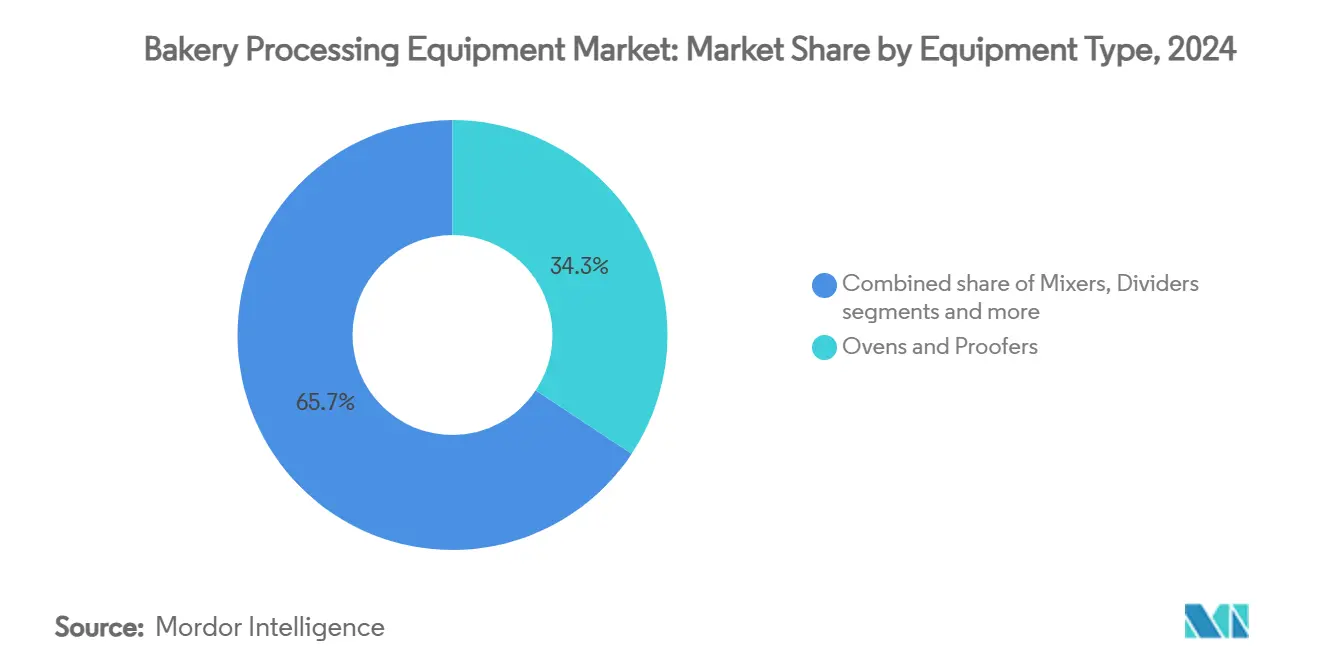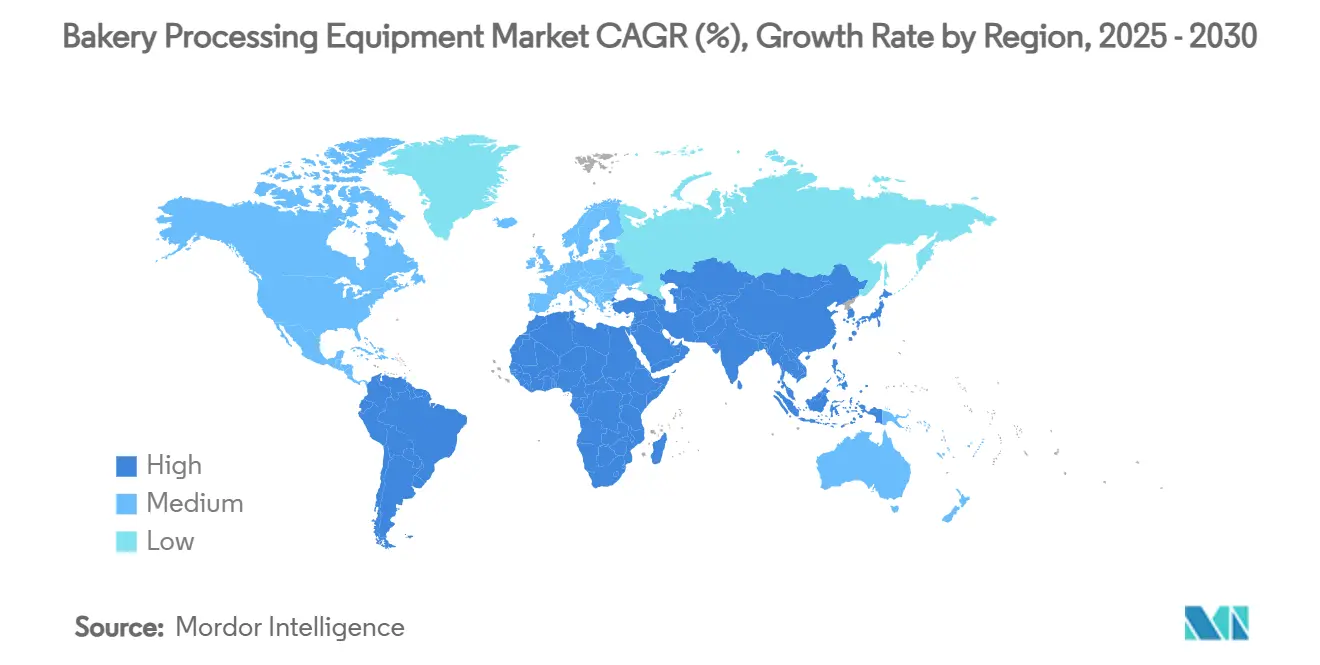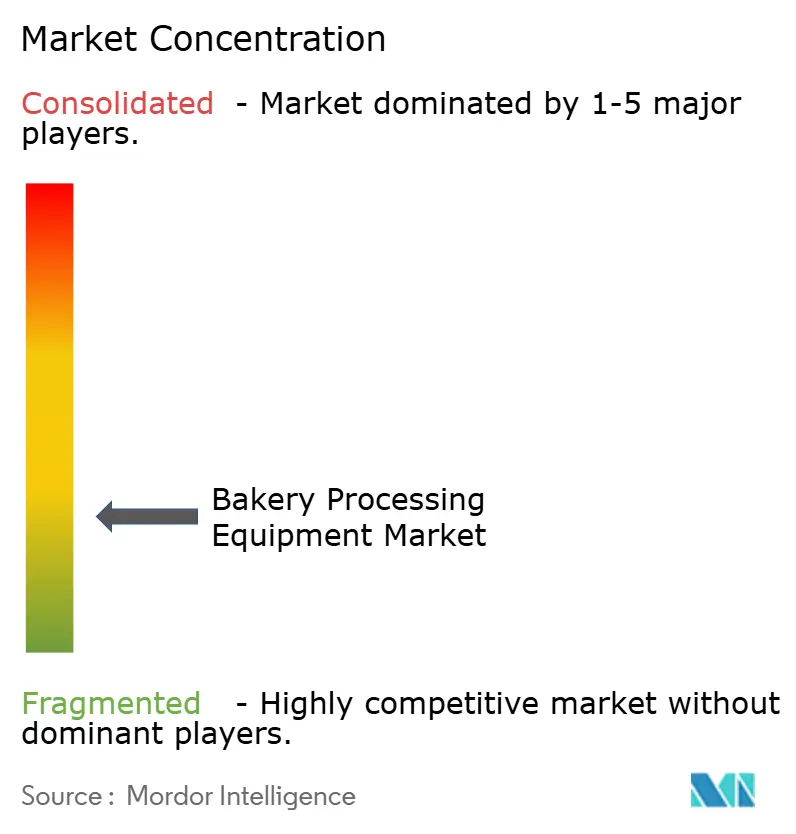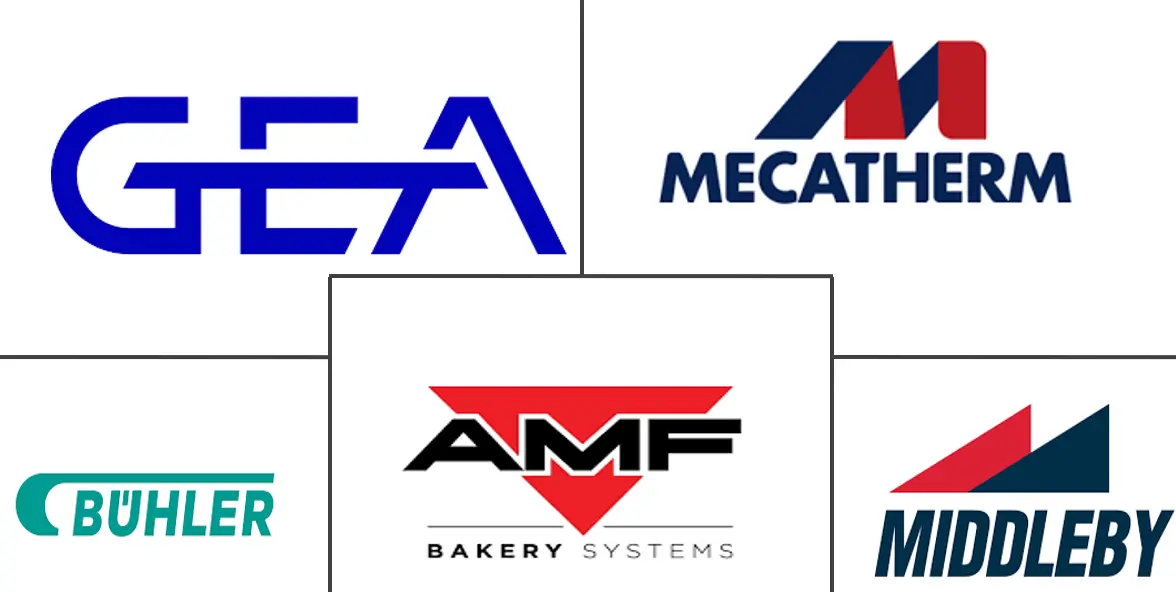Bakery Processing Equipment Market Size and Share

Bakery Processing Equipment Market Analysis by Mordor Intelligence
The bakery processing equipment market size is valued at USD 12.14 billion in 2025 and is projected to reach USD 15.55 billion by 2030, growing at a CAGR of 5.08% during the forecast period. This growth is driven by heightened automation demands in food manufacturing and a surge in the need for scalable, labor-efficient baking solutions. Reflecting this trend, companies are making significant investments: Bridor allocated USD 410 million in 2023 for new production facilities, and in 2024, Campbell Soup announced a USD 160 million expansion for its Goldfish brand, bolstering its baked goods operations. These investments highlight the industry's shift towards automation to cater to changing consumer preferences. The Asia-Pacific region is at the forefront of this market expansion, buoyed by China's swift modernization of industrial bakeries and India's burgeoning retail bakery scene. A testament to this growth, The Baker’s Dozen secured USD 5 million in 2024, aiming to deepen its presence in tier-II cities. As artisanal bread and pizza crust production gains traction, there's a noticeable pivot towards specialized equipment like sheeters and molders. The competitive landscape is underscored by strategic acquisitions, such as Middleby Corporation's buyout of GBT GmbH and Bühler Group's integration of Esau & Hueber, both emphasizing technological differentiation and automation.
Key Report Takeaways
- By equipment type, ovens and proofers held 34.32% of the bakery processing equipment market share in 2024, while sheeters and molders are advancing at an 8.91% CAGR through 2030.
- By application, bread and rolls captured 41.19% of the bakery processing equipment market size in 2024, whereas pizza crust equipment is projected to expand at a 9.24% CAGR through 2030.
- By mode of operation, automatic systems dominated with 68.78% share of the bakery processing equipment market size in 2024 and are growing at 7.83% CAGR to 2030.
- By end user, industrial bakeries accounted for 54.43% share of the bakery processing equipment market size in 2024; the HoReCa segment is registering the fastest 8.27% CAGR through 2030.
- By geography, Asia-Pacific dominated with 44.65% share of the bakery processing equipment market size in 2024 and is growing at 7.51% CAGR to 2030.
Global Bakery Processing Equipment Market Trends and Insights
Drivers Impact Analysis
| Driver | (~) %Impact on CAGR Forecast | Geographic Relevance | Impact Timeline |
|---|---|---|---|
| Technological advancement in baking equipment | +1.2% | Global; concentrated adoption in North America and Europe | Medium term (2-4 years) |
| Increased automation and higher hygiene standards | +0.8% | Global; post-COVID acceleration in all regions | Short term (≤ 2 years) |
| Rising global demand for bakery products | +0.7% | Asia-Pacific core; spill-over to Middle East and Africa and South America | Long term (≥ 4 years) |
| Growth of in-house bakeries and cafés | +0.6% | North America and Europe; expanding to Asia-Pacific urban centers | Medium term (2-4 years) |
| Energy efficiency and eco-friendly equipment trends | +0.5% | Europe leading; North America following; Asia-Pacific emerging | Long term (≥ 4 years) |
| Expansion of industrial-scale bakeries | +0.4% | Asia-Pacific dominance; North America capacity additions | Medium term (2-4 years) |
| Source: Mordor Intelligence | |||
Technological Advancement in Baking Equipment
Industry 4.0 technologies are propelling the bakery processing equipment market, driving automation, boosting efficiency, and slashing operational costs. Bakeries are swiftly integrating AI systems to streamline production and ensure consistency, especially for high-demand items like bread and pastries. Advanced self-learning robotics is cutting waste and swiftly adapting to various baked goods, negating manual recalibrations and enhancing throughput. Digital platforms enable real-time monitoring and predictive maintenance, curtailing equipment downtime and bolstering cost-efficiency for both large and mid-sized bakeries. In 2024, Rademaker unveiled its Smart Sheeting Line, boasting AI-driven consistency controls and remote diagnostics for precise dough processing. That same year, Mecatherm rolled out the M-NS scoring machine, featuring vision-guided blade adjustments that instantly adapt to the dough's type and texture. Echoing this trend, the U.S. Department of Agriculture (USDA) underscored in its 2024 Food Industry Report the pivotal role of automation and smart equipment in baking for ensuring supply chain stability and countering labor shortages [1]Source: United States Department of Agriculture, “2024 Food Industry Report,” usda.gov. With these innovations and government-endorsed efficiency boosts, the demand for advanced bakery equipment surges, propelling the market's growth.
Expansion of Industrial-Scale Bakeries
As industrial-scale bakeries expand, their demand for bakery processing equipment surges. Large operators are increasingly prioritizing automation and the capacity to handle high-volume production. These bakeries are investing in integrated systems, mixers, sheeters, ovens, and robotic depanners, all aimed at ensuring consistency, minimizing downtime, and boosting operational efficiency. Take, for instance, Grupo Bimbo's 2024 facility launch in Georgia, USA. It's outfitted with energy-efficient continuous mixers and automated packaging lines, underscoring the push for enhanced output. Equipment manufacturers are quick to innovate in response. A case in point is AMF Bakery Systems, which introduced a high-speed bun line that churns out over 2,000 buns every minute. Further emphasizing this trend, the 2024 Convention of the American Bakers Association revealed that nearly 70% of its member companies either have adopted or plan to adopt automation and AI within the next year, boosting capacity and streamlining labor and workflow [2].Source: American Bakers Association, “Navigating the Future: Convention Spotlights Automation, Community Impact and Sustainability,” americanbakers.orgSuch a widespread commitment to automation signals a robust momentum in the equipment market.
Rising Global Demand for Bakery Products
Global demand for bakery products is fueling the growth of the bakery processing equipment market. As consumers increasingly seek fresher and higher-quality baked goods, bakeries are turning to advanced, high-throughput systems to meet these rising production demands. A notable trend of premiumization is evident; the total dollar sales for bakery products climbed by 5.7% to reach USD 43.5 billion in 2024. This uptick underscores a heightened demand for premium, value-added offerings. Furthermore, with 6% of consumers pivoting towards either at-home or in-store bakery purchases, there's a pronounced need for flexible and efficient processing equipment [3]Source: Food Industry Association, “Power of In‑Store Bakery 2023,” fmi.org. Such equipment must adeptly handle a diverse array of product types and formulations. In light of these market shifts, bakeries are now emphasizing equipment that champions cleaner labels, specialty ingredients, and swift product innovation. The push for shorter production cycles and a wider variety of SKUs has led manufacturers to invest in modular and programmable systems. In 2024, Rondo unveiled the Smartline Flex, designed for rapid dough changeovers, while FRITSCH rolled out the Multiline M700, tailored for the precise shaping of health-oriented and artisanal products. These innovations empower bakeries to swiftly adapt to changing consumer trends, all while optimizing output efficiency.
Growth of In-House Bakeries and Cafés
In-house baking is becoming a pivotal driver for growth in the bakery processing equipment market, particularly within the HoReCa segment. Restaurants, cafés, and hotels are increasingly opting to bring baking operations onsite. This shift allows them to exert greater control over quality, guarantee product freshness, and craft signature menu items that set them apart in a competitive landscape. As a result, there's a burgeoning demand for compact, multi-functional equipment that delivers industrial-level performance while seamlessly fitting into constrained kitchen spaces. In 2024, Unox unveiled its Bakerlux Shop.Pro™ LED oven, designed for high-efficiency baking in front-of-house and small-format settings, striking a balance between visual allure and operational accuracy. In a similar vein, Turbofan by Moffat expanded its countertop convection oven range, introducing programmable models that cater to diverse product formats and batch sizes. These advancements underscore the accelerating demand for intelligent, scalable equipment solutions, empowering operators to offer fresh bakery experiences without the expansive footprint of traditional facilities.
Restraints Impact Analysis
| Restraint | (~) % Impact on CAGR Forecast | Geographic Relevance | Impact Timeline |
|---|---|---|---|
| High initial cost of advanced equipment | -0.9% | Global; particularly acute in emerging markets | Short term (≤ 2 years) |
| Steep learning curve and need for skilled labor | -0.6% | Global; most severe in developed markets with aging workforce | Medium term (2-4 years) |
| Growing preference for home baking or minimally processed products | -0.4% | North America and Europe; emerging in urban Asia-Pacific | Long term (≥ 4 years) |
| Volatility in raw material costs | -0.3% | Global; cyclical impact based on commodity cycles | Short term (≤ 2 years) |
| Source: Mordor Intelligence | |||
High Initial Cost of Advanced Equipment
Modern bakery processing equipment is becoming increasingly complex and automated, raising capital investment barriers, especially for small and mid-sized operators, as manufacturers weave in AI, IoT connectivity, and smart diagnostics, both acquisition and maintenance costs surge. This trend poses challenges for smaller bakeries striving to keep up with essential technological upgrades. Take, for example, AMF Bakery Systems’ Guardian Oven Assistant. While its AI-driven thermal control and predictive maintenance features promise notable efficiency boosts, the premium price tag predominantly attracts large-scale users. Likewise, the Mecatherm M-TA industrial oven, tailored for automated multi-product baking, ensures high-volume consistency but demands a hefty initial investment. Mid-market bakeries frequently find it tough to obtain favorable financing for such sophisticated systems. This scenario creates a landscape where larger entities enjoy enhanced production and cost efficiencies, leaving smaller firms grappling with dwindling margins. Consequently, a two-tier market emerges, hindering equipment adoption among resource-limited businesses, even as their operational demands grow.
Steep Learning Curve and Need for Skilled Labor
The complexity of modern bakery processing equipment is creating operational barriers, particularly due to the steep learning curve and persistent shortage of skilled labor. Advanced systems integrating AI, programmable logic controls, and real-time monitoring require trained technicians and bakers who can manage setup, calibration, troubleshooting, and maintenance, resources that many small and mid-sized bakeries lack. For instance, FRITSCH’s IMPRESSA bread line and Rademaker’s Crusto sheeter demand precision in configuration and recipe programming, which can result in operational inefficiencies or product inconsistency when not handled by skilled operators. Additionally, the transition from manual to automated processes often leads to resistance among legacy staff, increasing the need for retraining and slowing adoption timelines. In emerging markets, where formal vocational training in bakery machinery is limited, the lack of local expertise further restricts the installation and effective use of advanced systems, creating a bottleneck in market penetration despite rising demand. Furthermore, the high cost of training programs and certifications for operating these advanced systems adds to the financial burden for smaller bakeries. The limited availability of technical support services in remote or underserved regions exacerbates the challenges, delaying troubleshooting and maintenance activities.
Segment Analysis
By Equipment Type: Ovens Drive Volume, Sheeters Accelerate Growth
In 2024, ovens and proofers captured a dominant 34.32% share of the market, highlighting their pivotal role in commercial baking. Ongoing innovations in heating technologies bolster this leadership position. Advancements like hybrid systems and convection enhancements not only boost energy efficiency but also shorten bake cycles. Take MECATHERM’s convection ovens, for instance. They enable controlled baking at temperatures between 200–300°C, showcasing energy savings that make a compelling case for both new purchases and replacements.
On the other hand, sheeters and molders are emerging as the equipment segment with the fastest growth. They're set to grow at a CAGR of 8.91% until 2030, fueled by the expansion of artisanal and specialty bakery lines. These tools are vital for achieving the consistent thickness and texture demanded in premium products like sourdough bread and pizza crusts. Rondo’s Smartline system, for example, epitomizes this movement, providing precision automation for diverse dough types while catering to high-throughput requirements. As bakeries broaden their product ranges, the appetite for sheeters and molders is outpacing that for traditional equipment.

Note: Segment shares of all individual segments available upon report purchase
By Application: Bread Dominates, Pizza Crusts Surge
In 2024, bread and rolls commanded a dominant market share of 41.19%, buoyed by consistent global consumption and their pivotal role in both foodservice and retail. This segment's enduring stability underscores the product's universal significance across diverse cultures and dining moments. Consequently, equipment manufacturers are honing in on incremental efficiency boosts, like swifter proofing times and energy-efficient ovens, eschewing drastic design changes. Continuous innovations, such as automated bread lines from AMF Bakery Systems, are ensuring high-volume outputs without compromising on quality or texture consistency.
On the other hand, pizza crusts are emerging as the fastest-growing segment, with projections indicating a robust CAGR of 9.24% through 2030. This surge is largely attributed to the proliferation of quick-service restaurants (QSRs) and fast-casual dining establishments, both of which demand fresh and consistent dough. Responding to this burgeoning demand, equipment providers like Rademaker and Rondo are rolling out sophisticated sheeting and baking systems. Beyond pizza, other categories, cookies, pastries, and biscuits, are reaping the rewards of snacking trends, a preference for portion control, and a tilt towards premiumization.
By Mode of Operation: Automation Leads Across All Metrics
In 2024, automatic equipment commanded a dominant 68.78% market share and showcased the industry's most rapid growth, boasting a 7.83% CAGR projected through 2030. This trend underscores a pronounced pivot towards automation, not merely as an enhancement but as a strategic imperative. Bakeries, grappling with ongoing labor shortages and an escalating demand for consistent products, are increasingly turning to automation. This shift is most palpable in high-volume operations, where automation promises tangible benefits in throughput, quality control, and energy efficiency. Equipment such as AMF Bakery Systems’ Guardian platform and MECATHERM’s integrated baking lines is swiftly becoming essential investments for large-scale facilities, signaling a move to safeguard and optimize production.
To facilitate broader adoption, manufacturers are rolling out modular automation solutions. These allow bakeries to progressively transition from semi-automatic to fully automatic systems, a boon for mid-sized bakeries with tighter capital budgets. Furthermore, the integration of AI is on the rise, with modern systems boasting self-adjusting capabilities for mixing, baking, and portioning. This advancement renders automation feasible, even for product lines with intricate and fluctuating demands.

By End User: Industrial Scale Drives Volume, HoReCa Accelerates
In 2024, industrial bakeries dominated the market, capturing a 54.43% share, thanks to their large-scale production capabilities and investments in cutting-edge automation. Leveraging economies of scale, these bakeries utilize high-capacity equipment, seamlessly integrating systems for mixing, proofing, baking, and packaging. As these industrial facilities expand their product portfolios, there's a growing demand for flexible, programmable production lines. Highlighting this trend, Aspire Bakeries made headlines in 2024 with significant investments in facility upgrades and frozen cookie dough lines, emphasizing the industry's push for capacity growth and efficiency through state-of-the-art equipment.
On the other hand, the HoReCa sector is witnessing the most rapid growth, boasting a CAGR of 8.27% projected through 2030. Restaurants, cafés, and hotels are increasingly turning to in-house baking, seeking enhanced product freshness and distinct brand identity. This movement is particularly pronounced in urban areas, where space constraints make compact, multi-functional equipment a necessity. Positioned between the industrial and HoReCa sectors, the retail segment is also ramping up equipment adoption. Grocery chains are bolstering their in-store baking capabilities, driving a demand for nimble, space-efficient processing solutions. These solutions cater to premium offerings without the need for expansive production lines.
Geography Analysis
In 2024, Asia-Pacific commands a dominant 44.65% share of the global bakery processing equipment market and boasts the industry's swiftest growth rate at a 7.51% CAGR, projected through 2030. This robust positioning is driven by China's industrial modernization and India's brisk retail expansion. In India, bakery chains are ramping up operations to cater to the surging demand for fresh, premium baked goods. A testament to this trend, The Baker’s Dozen recently secured USD 5 million to broaden its footprint in tier-II Indian cities, underscoring the region's appetite for advanced, high-throughput equipment.
North America showcases a steadfast commitment to automated baking infrastructure, underscoring robust market confidence and industrial growth. Noteworthy investments, such as Bridor’s USD 410 million facility in Texas and Campbell Soup’s USD 160 million expansion in Richmond, highlight the region's drive to enhance production efficiency and cater to the escalating demands of the retail and foodservice sectors. This regional emphasis on automation is largely a response to broader labor challenges, leading to a pronounced shift towards high-capacity, labor-saving machinery.
While regions like South America and the Middle East and Africa are beginning to emerge as growth hotspots, their progress is often hindered by infrastructure challenges and economic fluctuations. Nevertheless, these markets are drawing attention from equipment providers, who are introducing scalable and durable systems tailored to navigate the local conditions and shifting consumer tastes.

Competitive Landscape
The bakery processing equipment market is fragmented. Established players are consolidating strategically to bolster their technological prowess and expand their geographic footprint. For instance, Middleby Corporation's acquisitions of GBT GmbH Bakery Technology and Gorreri Food Processing Technology underscore this trend, granting them access to niche product lines and specialized engineering know-how. Instead of merely chasing scale, industry leaders are focusing on broadening their portfolios and venturing into rapidly growing sectors to maintain their competitive edge.
As manufacturers weave AI, IoT, and automation into their offerings, competition sharpens. Adaptive robotic systems, like those from AMF Bakery Systems and Schubert, are now capable of real-time production data analysis, enhancing performance and trimming labor needs. The spotlight of innovation shines on energy efficiency, stringent hygiene standards, and compact design features that resonate with both industrial and foodservice operators. As bakeries pivot to cater to shifting consumer tastes, there's a rising demand for equipment that supports varied formulations and swift product transitions.
Developing regions, witnessing a surge in bakery modernization yet grappling with limited access to advanced machinery, present untapped growth avenues. In Southeast Asia and Sub-Saharan Africa, swift urbanization coupled with a burgeoning appetite for packaged baked goods is spurring investments in dependable, mid-range equipment. Take Kenya and Vietnam: bakery operators are broadening their horizons, but are still tethered to antiquated machinery. This gap paves the way for compact, energy-efficient solutions, meticulously crafted for local production demands.
Bakery Processing Equipment Industry Leaders
-
Bühler Holding AG
-
GEA Group Aktiengesellschaft
-
The Middleby Corporation
-
AMF Bakery Systems
-
Mecatherm S.A.
- *Disclaimer: Major Players sorted in no particular order

Recent Industry Developments
- January 2025: Puratos and AMF Bakery Systems launched a pilot bakery plant in Pennsauken, New Jersey. The facility was designed to support innovation and product development in industrial baking. It served as a collaborative space to test advanced bakery processing technologies.
- May 2023: GEA introduced sustainable bakery solutions at Interpack, including its Bake Depositor MO with reduced energy use and enhanced hygiene design. It also launched an electric oven retrofit kit, enabling 20% energy savings. The SmartControl interface was unveiled to streamline real-time bakery line monitoring.
Global Bakery Processing Equipment Market Report Scope
| Mixers | |
| Oven and Proofers | Gas Based Oven |
| Electric Based Oven | |
| Sheeters and Molders | |
| Dividers | |
| Others |
| Bread and Rolls |
| Cakes and Pastries |
| Cookies and Biscuits |
| Pizza Crusts |
| Other Bakery Porducts |
| Automatic |
| Semi-Automatic |
| Industrial Bakeries |
| HoReCa |
| Retail |
| North America | United States |
| Canada | |
| Mexico | |
| Rest of North America | |
| Europe | Germany |
| United Kingdom | |
| Italy | |
| France | |
| Spain | |
| Netherlands | |
| Rest of Europe | |
| Asia-Pacific | China |
| India | |
| Japan | |
| Australia | |
| South Korea | |
| Singapore | |
| Rest of Asia-Pacific | |
| South America | Brazil |
| Argentina | |
| Rest of South America | |
| Middle East and Africa | South Africa |
| Saudi Arabia | |
| United Arab Emirates | |
| Rest of Middle East and Africa |
| By Equipment Type | Mixers | |
| Oven and Proofers | Gas Based Oven | |
| Electric Based Oven | ||
| Sheeters and Molders | ||
| Dividers | ||
| Others | ||
| By Application | Bread and Rolls | |
| Cakes and Pastries | ||
| Cookies and Biscuits | ||
| Pizza Crusts | ||
| Other Bakery Porducts | ||
| By Mode of Operation | Automatic | |
| Semi-Automatic | ||
| By End User | Industrial Bakeries | |
| HoReCa | ||
| Retail | ||
| By Geography | North America | United States |
| Canada | ||
| Mexico | ||
| Rest of North America | ||
| Europe | Germany | |
| United Kingdom | ||
| Italy | ||
| France | ||
| Spain | ||
| Netherlands | ||
| Rest of Europe | ||
| Asia-Pacific | China | |
| India | ||
| Japan | ||
| Australia | ||
| South Korea | ||
| Singapore | ||
| Rest of Asia-Pacific | ||
| South America | Brazil | |
| Argentina | ||
| Rest of South America | ||
| Middle East and Africa | South Africa | |
| Saudi Arabia | ||
| United Arab Emirates | ||
| Rest of Middle East and Africa | ||
Key Questions Answered in the Report
What is the current size of the bakery processing equipment market?
The bakery processing equipment market size is USD 12.14 billion in 2025.
How fast is the bakery processing equipment market expected to grow?
It is projected to register a 5.08% CAGR, reaching USD 15.55 billion by 2030.
Which equipment category commands the largest bakery processing equipment market share?
Ovens and proofers lead with 34.32% share in 2024.
What is driving rapid automation adoption in bakeries?
Persistent labor shortages, higher hygiene standards, and AI-enabled quality control push automatic equipment to 68.78% share in 2024 and rising.
Page last updated on:



